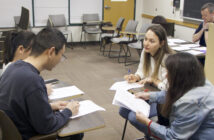Like many educators, Jeffrey Corpora teaches his Easton Area High School students to participate.
But it’s a different kind of participation than answering a question or raising a hand.
It’s a participation that extends to the surrounding environment — the community that Corpora works to make his advancement placement government and politics students care about as members of a democracy.
It’s why the classroom itself is adorned with posters of former presidents, maps of electoral college vote distributions and a sheet bearing the name of Matt Cartwright, congressman for Pennsylvania’s 17th district — the one EAHS falls into. It’s why lesson plans include learning about mass media, political framework and civil rights, Corpora said.
It’s why, when faced with the reality of low turnout from youth voters both nationally and locally, Corpora’s students aren’t at a loss for ideas on how to garner interest from their generation. Though many of the high school seniors are not yet legal voting age, the class has learned of its demographic’s hesitation to engage, and the perception of how the political sphere pushes youth away.
“I feel like most of the people that are running, they don’t care about us,” student Harneet Mandair said. “The points that they make are about the old(er) and the dying.”
In a study by Google, the top five searches pertaining to the 2016 national election issues are immigration, education, taxes, economy and gun control.
When it comes to issues such as these, particularly ones that are finance-based and seemingly geared toward older generations, student Victoria Bertolini believes “students still live with their parents, so they don’t have an issue to fight for.”
But when asked about the points that do interest them, the class’ answers come enthusiastically and in unison. Student loans, college debt. The sort of problems that matter to 18-year-olds, they said.
But the very same students said they don’t feel as though politicians cover these topics.
“The issues don’t really involve (young people), and the candidates know that,” Bertolini said. “So they don’t campaign to those people.”
If a candidate were to actively campaign toward younger voters, Bertolini said she believes they’d win the majority of the youth vote.
But the responsibility of garnering engagement does not solely belong to candidates. Corpora said his course teaches students to be aware and strive to understand the issues.
It’s not without struggle. Corpora and his students know this.
“People our age sometimes think they’re always right,” student Sydney Anderson said. “So they’re not really open to seeing other people’s opinions.”
The solution to this may be in the education system, according to some students. Corpora said pupils have said they wish they could’ve taken the course earlier.
“Start in schools to actually educate,” student Aly Kenawy said. “A lot of people are really ignorant and don’t know both sides of actual politics. So the school should teach you in an unbiased manner so you can go to the outside world and choose.”
Only 19.9 percent of youth voters — 18 to 29-year-olds — voted in the 2014 elections, according to a study from CIRCLE, a civic research center. But the knowledge of low numbers hasn’t stopped Corpora and the high school’s administration in their mission to “expose (students) to as much (politically) as we can.”
Not only are all seniors required to take a government course in their final year of school, but the advanced placement class must attend at least three local government meetings. EAHS runs voter drives and provides the opportunity for of-age students to register themselves, according to Corpora.
“So being a participant is ingrained in the overall curriculum,” he said.
In Corpora’s class, that message has gotten through.
“I’ve learned that if I want to change something, I have to do something about it,” Mandair said. “I can’t just sit here and complain.”





Comment policy
Comments posted to The Brown and White website are reviewed by a moderator before being approved. Incendiary speech or harassing language, including comments targeted at individuals, may be deemed unacceptable and not published. Spam and other soliciting will also be declined.
The Brown and White also reserves the right to not publish entirely anonymous comments.